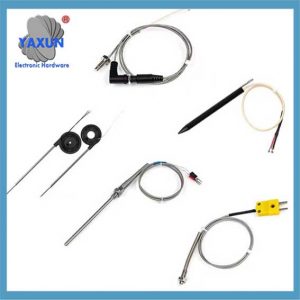Thermistor NTC Temperature Sensor Probe Basics & Application Design
Q: How fast does an NTC respond?
A: Response time is defined as the time it takes to reach 62% or a new temperature and is a function of mass. The smaller the sensor, the faster it responds. A discrete sensor responds faster than when it is enclosed in a metal housing. NTC thermistor sensors typically have a response time of < 15 seconds.
Q: Are NTCs small in size?
A: Epoxy-coated discrete sensors typically have a maximum outer diameter of 0.95″ and miniature glass sensors have a maximum outer diameter of 0.15″.
Temperaturni senzor NTC
Q: How stable are NTC sensors?
A: Different sensor families have different stability ratings. Epoxy-coated NTCs have lower stability than sealed glass NTC sensors.
Q: How do you choose a resistance value for your application?
A: Na splošno, use low resistance sensors in low temperature applications and high resistance sensors in high temperature applications. The goal is to have an operating resistance value that is within the temperature range of interest.
Q: Can NTCs be used in cryogenic applications?
A: ja, but the accuracy at -200°C is based on mathematical modeling.
Q: What is the difference between a thermistor and an RTD?
A: There are 5 distinct technologies produced in temperature products. Each technology has its advantages and disadvantages, and which technology is best suited for a particular application will depend on a number of factors, including temperature range, required accuracy, time response, stroški, and many other factors.
Q: Can you demonstrate the math behind converting from % tolerance to actual temperature tolerance?
A: To determine temperature accuracy, simply divide the total deviation (resistance tolerance) by the Alpha value at the temperature of interest.
Na primer: A sensor has a 2% resistance at 0°C, and according to curve #3, the 0°C Alpha is 5.2%/°C, so the accuracy is calculated as: 2/5.2= ± 0.38°C
Q: Does the accuracy specification for thermistors include long term resistance change (resistance stability)?
A: Ne, the accuracy specified is the accuracy of the sensor when it leaves the factory. When used in the field, the sensor will be affected by application or environmental conditions that cannot be controlled.
Q: What does the “%” mean when referring to temperature accuracy?
A: Sensor accuracy can be specified as a resistance tolerance (see question 9), or as temperature accuracy at a point or span. Na primer: ±0.2°C accuracy from 0°C to 70°C.
Q: Ali lahko bolj podrobno razložite ločljivost občutljivosti?? Zakaj so višje vrednosti boljše?
A: Visoka občutljivost odpravlja kakršen koli upor svinca. Prav tako poenostavlja podporno elektroniko. A 10,000 ohmski termistor spremeni upornost za 4.4% oz 440 ohmov za spremembo temperature za 1 °C. A 100 ohm platinasti senzor spremeni upornost za 1/3 ohm za spremembo temperature za 1 °C.
Q: What does the Y-axis portion of the stability represent?
A: The Y-axis is intentionally drawn, and there are no actual numbers on the scale. Aging rates will vary by formulation and form factor.
Q: Any suggestions on electronics to optimize accuracy and speed? (Amplifiers, ADCs, itd.)
A: When designing precision measurement circuits, the primary concern should be limiting the current through the components. NTC resistor specifications are referred to as zero-power resistor values. While it is not possible to have a true zero-power circuit, the current should be low enough to not cause significant self-heating of the sensor element. The amount of self-heating error for a given power input can be estimated using the dissipation constant.
Q: If a voltage divider adjustment is used for a 10K or 20K NTC, are there any special considerations for reducing electrical noise for cables 20 do 60 feet long?
A: Cable shielding or ferrite filters on long cables can be used to mitigate noise effects. Averaging is also an option.
Q: Do you have any recommendations for bonding thermistors to metal surfaces?
A: Adhesives are used to bond thermistors for surface temperature measurements in many applications. Thermally conductive adhesives (usually epoxy) provide the best results.
Q: Are there standard NTCs for lithium batteries?
A: There are no standards for lithium battery packs. The choice of NTC is usually based on available space, maximum temperature, and assembly method. I have seen insulated lead epoxy coated discrete thermistors, SMD thermistors, and DO35 glass shaft thermistors used in this application.
Q: Are there any white papers or technical papers on the resistance method of soldering thermistor leads?
A: None at this time. The lead alloys used are Alloy 180 (Cu:V), Baker, Nickel, or Dumet (Fe:V). The soldering method varies depending on the alloy type.
Q: What type of NTC thermistor is used for medical thermometer applications?
A: An industry standard left over from the analog days. 1355 ohms at 37°C, Beta 25/85=3976. Medical thermometer standards typically specify an accuracy of +/-0.1 za 32 to 42°C and +/-0.2 for 25-50°C or 0-50°C for the measurement system, with half of this tolerance allocated to the thermistor and the other half to the measurement circuitry.
 English
English العربية
العربية Български
Български 粤语
粤语 中文(简体)
中文(简体) 中文(漢字)
中文(漢字) Nederlands
Nederlands Suomi
Suomi Français
Français Deutsch
Deutsch Ελληνικά
Ελληνικά Magyar
Magyar Italiano
Italiano 日本語
日本語 한국어
한국어 Polski
Polski Português
Português Română
Română Русский
Русский Slovenščina
Slovenščina Español
Español Svenska
Svenska ภาษาไทย
ภาษาไทย Türkçe
Türkçe Tiếng Việt
Tiếng Việt






